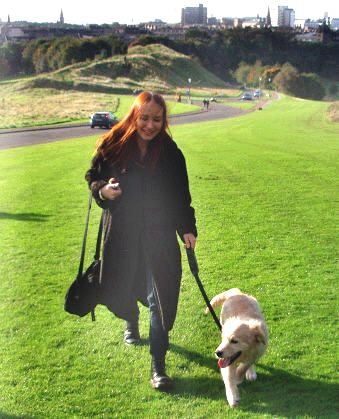Switzerland
The Story Behind ‘Fighting It’
 This is the first piece of sustained writing I have attempted in a very long time.
This is the first piece of sustained writing I have attempted in a very long time.
It all started last summer, with our golden retriever’s belly swelling up – a phantom pregnancy, the vet said. Then there was the smell of rotting wood in our toilet – a leaking joint along the cistern pipe, my husband said. Then my blood test came back – a slight anomaly, my GP said. Nothing serious.
No, nothing serious, except for that shaky feeling in the pit of my stomach. Like I was waiting for a train to hit me, but so far all I could hear was its whistle in the distance.
Our dog had to be put down because her abdomen turned out to be full of blood from a ruptured liver tumour. The toilet bowl needed replacing; it was leaking and balanced on nothing but a cracked waste pipe, no flooring, with potentially lethal consequences for our downstairs neighbour. And I was diagnosed with bowel cancer.
I had been hit at last. I felt almost – and rather perversely – a sense of relief.
When, barely a week later, we heard from Edinburgh City Council that the three-year-old statutory notice for building repairs on our tenement (back and front stone replacement and roof work) was finally going to be enforced, it couldn’t have happened at a better time. Everything was up for renewal: me, the family, the house.
We fetched our new puppy on 1st August, the Swiss National Day, three days before I started my five-week course of combined radio- and chemotherapy.
The only other ray of light, which was to help me cope (and retain my sense of being a writer, in spite of everything) during the bleak days and months ahead, had come while everything else around me was beginning to fall apart: Two Ravens Press had accepted my collection of stories, called aptly (if coincidentally) ‘Fighting It’.
But it didn’t seem like I was fighting anything. Not yet. My first act after being diagnosed was to sift through the food stocks and spices in the kitchen cupboards, throwing out past-sell-by-dates, then refilling and labelling the jars – a bit like editing a text that has grown stale over time. My clothes were next. Some went to charity shops. A bellflower blue-green-and-white silk dress seemed made for a French artist friend. And then I was ready for a visit to Maggie’s Centre – such an uplifting place, in stark contrast to the Cancer Centre nearby.
Perhaps being a writer with an over-active imagination helped me picture (and prepare for) what lay ahead. I joined a young women’s group at Maggie’s and signed up for workshops: managing hair loss (the thought of losing my long hair was unimaginable); how to look good (and feel better); and Relaxation/Visualisation. With a girlfriend I went to a wig shop where I selected a couple of wigs – one with flowing long hair, the other cropped boyishly short. The latter was going to be my ‘real hair’, newly styled. The former my ‘real wig’, for glamour. That’s how I planned to keep my baldness a secret – with a story of reinvention.
On the first few days of my treatment I had to give two readings with my husband Ron Butlin, Edinburgh’s Poet Laureate (at Word Power Books to open the Edinburgh Fringe Book Festival, and at the National Library of Scotland). It felt good to stand there in front of packed audiences, pretending for those short moments that everything was fine. Ten days later I had another gig (at the Edinburgh International Book Festival). By this time, though, the strain of the treatment was beginning to tell and I had to fight exhaustion. I felt dissociated from my surroundings, as if I was in three places at once: performing in the bookshop tent with a cameraman filming me for a promo for Edinburgh UNESCO City of Literature, popping chemo tablets labelled ‘cytotoxic’ (use gloves when handling) at our kitchen table, and lying immobile, half-naked, on the hard surface of the hospital’s radiotherapy machine, counting down the seconds as I visualised those bastard cancer cells being laser-blasted to kingdom come. Yes, visualisation was me at my most creative in those first weeks of hell.
Eventually I became too weak to catch the daily bus to hospital and had to be chauffeured like a decrepit old lady by friends (we’d sold our car years ago). When my weight dropped below forty kilos, I stopped checking. Into the fourth week I got so sick I had to be hospitalised, ending up in a cancer ward where I hid my pain and myself behind the curtains. I was taken to the radiotherapy department in a wheelchair – and I couldn’t have cared less. The books I had brought stayed in my bag. The writing notebook remained unopened. Nothing but my pain was real now. And my not being able to eat. But then, the food wasn’t exactly tempting – the only meal I remember enjoying even slightly was a plateful of cauliflower cheese… The night before I was allowed home, one of the nurses suggested I go and see the Edinburgh Fireworks from the ward balcony. I shivered as I watched the display in the company of two other patients, one of them an intrepid smoker emaciated to stick thinness, the other attached to several tubes on wheels. Transience and mortality had never been brought home to me more poignantly.
The treatment left me near-debilitated. Just as it finished, the builders’ scaffolding went up, shrouding the house. Workmen began drilling and banging away – and it felt eerily right, the building being attacked on all sides. I was bedridden for over a month, unable to sleep, unable to read, to listen to music, or even to watch TV. Unable to write. My body was on fire from the effects of the radiotherapy – I had an unnatural tan and my skin began flaking off. Ron was frantic with worry and exhaustion. Friends brought food, lent us their car, vaccinated Leila-puppy, telephoned, sent flowers, gifts, cards and emails to cheer me up. Eventually, Ron couldn’t cope with the added stress of Leila’s friskiness any longer – friends took her in for days at a time, then weeks. My mother flew over from Switzerland to look after us. We both needed her desperately; poor Ron was close to collapse. When she left, I was able to go for short walks again. And we got Leila back. Friends gave us their bijoux gatehouse to stay in because the tenement stairs were too much for me. Soon afterwards, my sister and her family arrived to help.
Thanks to the treatment, the tumour had shrunk to near-nothing. I now had exactly two months before the operation in early December. Two months that I spent training and playing with Leila and revising the stories in Fighting It one last time. My publisher visited to show me a mock-up of the cover – it was to become my talisman in hospital. I also took part in the launch of an anthology which contained a reprint of my story ‘The Death Queue’ – my only ‘cancer story’ and written several years before I myself was diagnosed. It felt incredibly life-affirming and therapeutic to re-engage with the outside world as well as with my identity as a writer, tinkering with work that was very nearly finished.
With a week to go until my operation, we moved back into our flat – to find the boiler leaking and beyond repair. First the toilet, now this! As if the house was playing a grim joke on us, imitating my body’s faulty ‘plumbing’.
In hospital the night before my operation, I jotted down various ideas for stories, projecting myself into a happier future. Later on as I lay in the semi-darkness, I fantasised about waking from the operation without the temporary ileostomy bag; I bargained, made promises, implored my body to be strong. Reality, of course, caught up with me. It always does. Recovering in the High Dependency Ward the following afternoon, I was presented with a vanity stoma kit. And that was that. Fighting it was no use; I was too weak, anyway – until the ketamine used in the anaesthetic kicked in, making me believe that the hospital staff were plotting to kill me, which rallied my spirits. But that’s another story…
Due to a minor complication that led to my abdomen being filled with blood (an eerie parallel to what had happened to Amber, our retriever), I needed another operation, and another general anaesthetic, without ketamine this time. Just before being wheeled off to the operating theatre, late on a Saturday night, I touched up my make-up. Ron thought I was mad. ‘What’s the problem?’ I asked, tersely. ‘You should worry when I don’t do this anymore.’
While Ron sat waiting for me outside the operating theatre, anxious and worn-out, he tried to lose himself in a new poem he had been commissioned to write for the Lord Provost’s Banquet – about ‘vibrant Edinburgh’. Imagination really does have the power to relieve, and release, us.
Christmas was only a week away when I checked myself out of hospital, ‘against doctors’ advice’. Although the operations and my response to the treatment had been a complete success (I never even lost my hair), my salt levels were dangerously low, probably due to my ‘bag’ and the fact I hadn’t been able to keep any food down. The vomiting stopped the instant I got home. A cheerful little Christmas tree had been set up next to my camp bed in the living room, my new sleeping quarters.
I had the best carers in the world: Ron answered get-well cards, calls and emails, organised my daily trips to the surgery for blood tests, the shopping etc, while my parents, having prolonged their stay in Scotland, cooked, cleaned, mended and fixed things in the flat and helped with Leila. I made a fast recovery – despite the hateful bag, which cramped my style, forcing me to wear loose clothing. Soon, I was well enough to proofread Fighting It and to take Leila for longer and longer walks. By the end of February I was back ‘on stage’ – at a fundraiser for Gaza. And a few days later, at the Glasgow Homoeopathic Hospital, I learnt how to inject myself with Iscador, a mistletoe extract to boost the immune system.
 I have just returned from another stint in hospital and am once again, and very gratefully so, ‘bagfree’. Maybe it really is third time lucky: the operation went smoothly; I was given a room of my own, and I found that the menu had been changed, apparently in the past month. I was able to eat, enjoy, and thrive.
I have just returned from another stint in hospital and am once again, and very gratefully so, ‘bagfree’. Maybe it really is third time lucky: the operation went smoothly; I was given a room of my own, and I found that the menu had been changed, apparently in the past month. I was able to eat, enjoy, and thrive.
The scaffolding came down in March, after seven months of dust and darkness. The new slabs of stone are pale gold in the sunlight; the roof is now watertight; the birds have reclaimed the garden. Fighting It will be launched on 18 June, our wedding anniversary. It feels like a cloud has lifted. And I am ready to start afresh.
© Regi Claire 2009
Fighting It by Regi Claire is published by Two Ravens Press £9.99
ISBN: 978 1 906120 41 2
Publication date: June 2009
Buy from Two Ravens Press for £7.99: http://www.tworavenspress.com/HTML-Pages/Fighting-It.htm

Comments